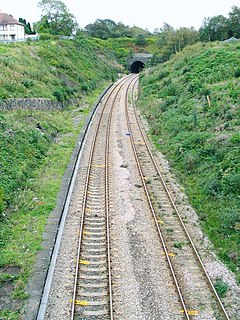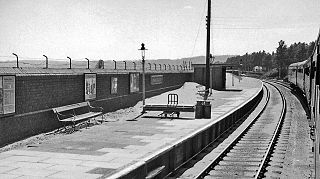The Rhymney Railway was a railway company in South Wales, founded to transport minerals and materials to and from collieries and ironworks in the Rhymney Valley of South Wales, and to docks in Cardiff. It opened a main line in 1858, and a limited passenger service was operated in addition.
The Brecon and Merthyr Tydfil Junction Railway (B&MR) was a railway company in Wales. It was originally intended to link the towns in its name. Finding its access to Merthyr difficult at first, it acquired the Rumney Railway, an old plateway, and this gave it access to Newport docks. This changed its emphasis from rural line to mineral artery.

The Swansea Vale Railway (SVR) was a railway line connecting the port of Swansea in South Wales to industries and coalfields along the River Tawe on the northern margin of Swansea, by taking over a tramroad in 1846. It was extended to Brynamman in 1868. Passengers were carried from 1860, and a loop line through Morriston was built.

Pontarddulais railway station serves the town of Pontarddulais and village of Hendy in Wales. The station is located at street level not far from the town centre and the Loughor estuary. All trains serving the station are operated by Transport for Wales.

Llangammarch railway station serves the village of Llangammarch Wells in Powys, Wales. Situated near the centre of the village, the station is on the Heart of Wales Line 56¾ miles (91.3 km) north east of Swansea.
The Llanelly Railway and Dock Company was an early Welsh railway system. It opened its first short line and a wet dock at Llanelly in 1834, and soon went on to build a longer line from Llanelly to serve pits in the Amman Valley, and then on to Llandilo, reached in 1857. The Llanelly company leased and worked the Vale of Towy Railway on to Llandovery, from 1858.
The Vale of Neath Railway was a broad gauge railway company, that built a line from Merthyr Tydfil and Aberdare to Neath, in Wales, chiefly to transport the products of the Merthyr iron industries to ports on Swansea Bay.
In 1861 the Llynvi Valley Railway was opened in Glamorganshire, Wales, to convey mineral products to the Bristol Channel at Porthcawl. It adopted an earlier tramroad, the Duffryn Llynvi and Porthcawl Railway. The Llynvi and Ogmore Railway was opened in 1865, and the two companies amalgamated to form the Llynvi and Ogmore Railway in 1866. At first Porthcawl harbour was an important destination for onward transport, but this soon declined.
The South Wales Railway was a main line railway which opened in stages from 1850, connecting the Great Western Railway from Gloucester to South Wales. It was constructed on the broad gauge. An original aspiration was to reach Fishguard to engender an Irish ferry transit and transatlantic trade, but the latter did not materialise for many years, and never became an important sector of the business. Neyland was the western terminus of the line until 1906.
The Dulas Valley Mineral Railway was incorporated in 1862 to bring coal from the Onllwyn area north-east of Neath to the quays there, and in the following year was reconstituted as the Neath and Brecon Railway. The line was opened as far as Onllwyn in 1863.
The Rhondda and Swansea Bay Railway was a Welsh railway company formed to connect the upper end of the Rhondda Fawr with Swansea, with the chief objective of transporting coal and other minerals to Swansea docks. It was incorporated in 1882, but at first the connection to Swansea from Briton Ferry was refused.
The Manchester and Milford Railway was a Welsh railway company, intended to connect the industrial areas of Northwest England with a deep-water port on Milford Haven, giving an alternative to the Port of Liverpool.
There are 22 disused railway stations in the 75 miles (121 km) between Bristol Temple Meads and Exeter St Davids, 12 of which have structures that can still be seen from passing trains. Most were closed in the 1960s but four of them, especially around Weston-super-Mare, were replaced by stations on new sites. 13 stations remain open on the line today, but there have been proposals to reopen stations at Cullompton and Wellington.
The Bangor and Carnarvon Railway was a railway company promoted to build a branch railway connecting Caernarfon with the main line at Bangor, in north-west Wales. It opened in 1852 as far as Port Dinorwic and was extended to Caernarfon later in the same year.
John Dickson (c1819-1892), was a railway contractor responsible for the promotion, construction and operation of several railway lines in England and Wales, especially in and around Swansea. His finances were never securely based and he was forced into bankruptcy on three occasions.

Colbren Junction was a railway station on the Neath and Brecon Railway. The station, which was near Coelbren, was completed at the same time as the Swansea Vale and Neath and Brecon Joint Railway opened a seven-mile branch from here to Ynysygeinon in 1873. It was a key junction in the networks operated by the Midland, Neath and Brecon, and Great Western railway companies.

Cockett station was a former station on the West Wales Line from Swansea to Gowerton and onwards to Llanelli.

Swansea Bay is a former railway station in Swansea next to Swansea Bay, in South Wales, opened to passenger and goods traffic on 14 December 1867. Owned successively by the Llanelly Railway and Dock Company, the Swansea and Carmarthen Railways Company, the London and North Western Railway Company, the London, Midland and Scottish Railway Company and British Railways, it was served by trains to and from Shrewsbury, Crewe, Liverpool, Manchester and York and formed the southern terminus of the Central Wales line, most of which is still operational as the Heart of Wales Line. Swansea Bay closed in June 1964, having been listed in the Report on the Reshaping of British Railways the previous year. The former station is near Blackpill and the Clyne Valley Country Park and was adjacent to the Swansea and Mumbles Railway which was closed in 1960. Much of the trackbed is now part of the A4067 road towards Swansea Victoria.
The Great Western Railway was a railway company that was dominant in West Wales, in the United Kingdom.
Baglan Sands Halt railway station was a railway station on the Rhondda and Swansea Bay line which ran from the Rhondda Valley to Swansea on the Welsh coast in the county of Glamorgan.






